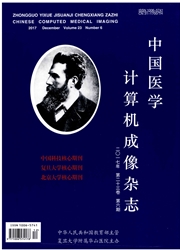

 中文摘要:
中文摘要:
目的:探讨人脑胶质瘤患者256层CT灌注成像灌注参数在评价胶质瘤肿瘤血管生成中的价值。方法:应用256层CT对病理证实胶质瘤患者40例及正常对照组15例行脑256层CT灌注扫描。利用Mi STAR后处理软件,获得感兴趣区的灌注参数:CBF、CBV、MTT和表面通透性。采用SPSS 17.0软件,CBF、CBV、MTT和表面通透性与病理指标CD105-MVD、VMI、CD34-MVD、α-SMA-MVD之间的相关性用Pearson相关分析。结果:CBF、CBV和表面通透性与免疫组化指标CD105-MVD、VMI、CD34-MVD以及α-SMA-MVD有明显相关性(P〈0.05)。结论:人脑256层CT灌注成像灌注参数CBV、CBF和表面通透性可以一定程度上反映胶质瘤的肿瘤血管生成情况。
 英文摘要:
英文摘要:
Purpose: To analyze the relationship between perfusion parameters and human glioma angiogenesis. Methods: Perfusion CT (PCT) imaging was performed on 40 patients with histopathological provn gliomas and 15 healthy volunteers who were served as controls. The raw data were processed using CT perfusion software. Perfusion parameters including cerebral blood flow (CBF), cerebral blood volume (CBV), mean transit time (MTT) and permeability surface-area product were recorded. The statistical analysis was performed using the SPSS 17.0 package. Pearson correlation coefficients were used to investigate relationships between CBF, CBV, permeability surface-area product and the results of CD105- microvessel density (MVD), vascular maturity index (VMI), CD34-MVD and ct-SMA-MVD. Results: Significant correlations were observed between CD105-MVD, VMI, CD34-MVD, α-SMA-MVD and CBV, CBF, permeability surface-area product (P〈0.05). Conclusion: PCT could provide useful parameters, such as CBF, CBV and permeability surface-area product, which correlate well with glioma angiogenesis.
 同期刊论文项目
同期刊论文项目
 同项目期刊论文
同项目期刊论文
 期刊信息
期刊信息
